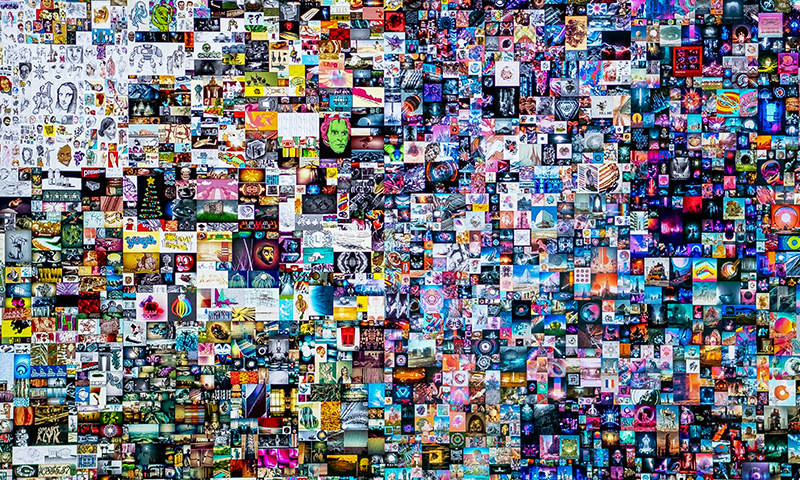Tech Talk: NFTs Unleash New Potential For Creators, Brands

Image: This piece of digital art, The First 5,000 Days, is the highest-selling NFT to date—it sold for $69 million.
The term “non-fungible tokens” (NFTs) has gleaned headlines as of late, with seemingly every well-known brand, from Taco Bell to Pringles to Charmin, and even musicians, artists and other creators, getting involved in some form, and doing so rather quickly. In mid-March, Pizza Hut sold its first-ever NFT, a digital, pixelated rendering of a pizza that’s part of a limited collection of its “1 Byte Favorites” on Rarible—a platform allowing artists to sell digital works via blockchain—for $0.0001 ETH (Ethereum, a cryptocurrency), equivalent to $8,824 USD. At press time, the highest-selling NFT to date was sold by Christie’s at auction for a whopping $69 million. The work, titled The First 5,000 Days, is a collection of digital art created by artist Mike Winklemann, known as Beeple, over the course of 5,000 days, or nearly 14 years, which he originally started as a way to refine his art skills. On a lesser scale albeit still in the six-figure range, artist Christopher Torres grossed $600,000 from the sale of his digital animation, the “Nyan cat” meme, which portrays a flying cat with a Pop Tart for a body. According to CNBC, at press time the NFT market was valued at more than $400 million.
So, what exactly is an NFT?
NFTs, which exist strictly in the digital space, appear complex at first, but it boils down to a simple understanding: much like we purchase commodities with currency in the real world or through ecommerce, such as cars, clothes or collectibles, NFTs are assets that hold monetary value in the cryptocurrency world, and they can be sold on a blockchain, which is a digital database that supports cryptocurrencies such as bitcoin and Ethereum. Essentially, the process can be summed up as a virtual marketplace involved in the buying and selling of digital work. The most important part of NFTs are not in the assets themselves, but in the information these assets store, which may permit purchasers to access exclusive content and tap into unique experiences. And because of this, it holds a wide range of opportunity and potential for brands.
Certainly, with the creation of digital art comes the concern that it can be replicated or lost. NFTs, first and foremost, are unique in that they cannot be duplicated. An NFT essentially stands as a certificate of authenticity for an exclusive digital work. Just like with tangible art, such as paintings or sculptures, purchasing the work holds greater value than a duplicate. There are millions of reproductions of Van Gogh’s Starry Night and Vermeer’s Girl with a Pearl Earring, but there is only one original of each, and though you can access the Nyan cat meme through a quick search on Google, there is only one person who owns it. However, arguably one of the most confusing parts of NFTs is that those who own them do not have rights to the actual asset. Although someone owns the Nyan cat meme, the original creator still possesses intellectual and creative rights, according to CNET. The other downside? Even though NFTs run on computers, the running and use of blockchain requires a colossal amount of processing power. According to Digiconomist.net, per transaction, Ethereum uses enough energy to power a household in the U.S. for more than two days.
How does it work?
NFTs are seen as digital assets that are tied to “tokens,” which hold monetary value in cryptocurrency. NFTs are varied, with some tokens being tied to digital art, trading cards or video clips, and others to tweets, memes or piece of music. With NFTs, artists and companies alike can decide whether they wish to sell a one-off work, or whether they wish to sell a collection or several copies of an original work. And possibly the best part, sellers can continue to earn a percentage from the sale of their works, even after they are sold.
Creators and brands, thus far, have begun tapping into the NFT market as a way to sell digital assets, which are referred to as “tokens.” DJs and musicians Deadmau5 and Steve Aoki have made and sold NFTs, while rock band Kings of Leon released its latest album, When You See Yourself, as an NFT. Nike has reportedly registered for a patent for “tokenized shoes,” writes CNN, known as “CryptoKicks.” And with more individuals, investors and brands tapping into the NFT industry by the day, we’re only likely to see more innovative assets and unique creations being made and sold.
–––––––––––––––––––––––––––––––––––––––––––––––––––––––––––
Danielle Renda is associate editor of PPB.

